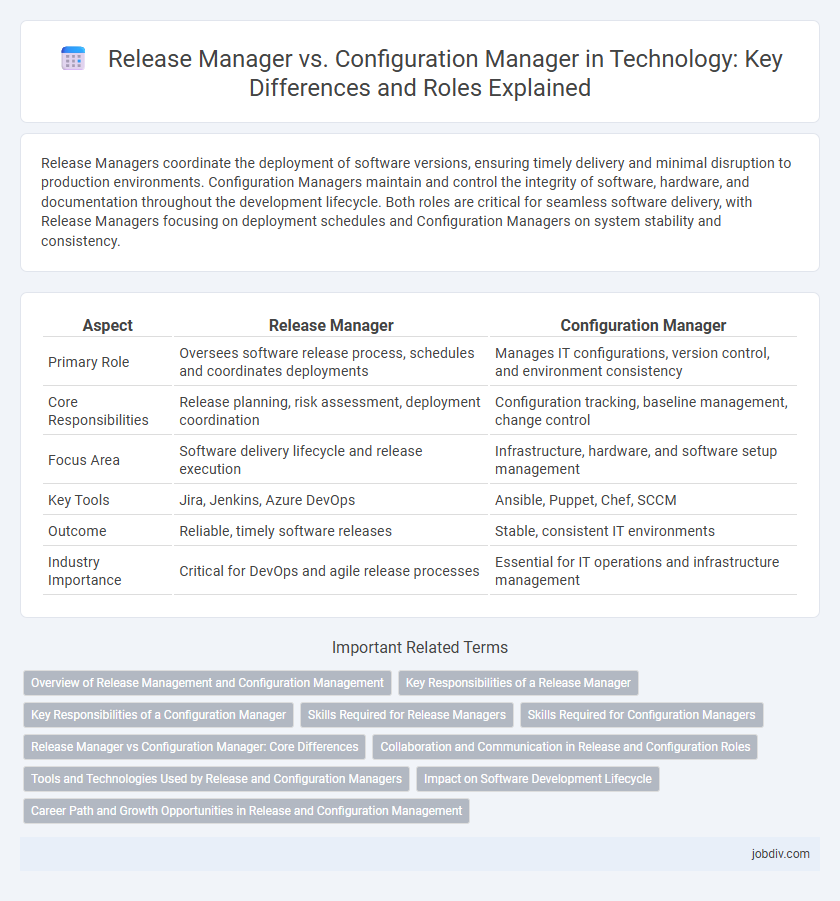Release Managers coordinate the deployment of software versions, ensuring timely delivery and minimal disruption to production environments. Configuration Managers maintain and control the integrity of software, hardware, and documentation throughout the development lifecycle. Both roles are critical for seamless software delivery, with Release Managers focusing on deployment schedules and Configuration Managers on system stability and consistency.
Table of Comparison
| Aspect | Release Manager | Configuration Manager |
|---|---|---|
| Primary Role | Oversees software release process, schedules and coordinates deployments | Manages IT configurations, version control, and environment consistency |
| Core Responsibilities | Release planning, risk assessment, deployment coordination | Configuration tracking, baseline management, change control |
| Focus Area | Software delivery lifecycle and release execution | Infrastructure, hardware, and software setup management |
| Key Tools | Jira, Jenkins, Azure DevOps | Ansible, Puppet, Chef, SCCM |
| Outcome | Reliable, timely software releases | Stable, consistent IT environments |
| Industry Importance | Critical for DevOps and agile release processes | Essential for IT operations and infrastructure management |
Overview of Release Management and Configuration Management
Release Management oversees the planning, scheduling, and control of software builds through different stages and environments, ensuring reliable and timely delivery of applications. Configuration Management focuses on maintaining consistency of a product's performance, functional, and physical attributes by tracking and controlling changes in the software configuration throughout its lifecycle. Both disciplines are critical for effective DevOps practices, with Release Management emphasizing deployment processes and Configuration Management ensuring traceability and integrity of system components.
Key Responsibilities of a Release Manager
A Release Manager oversees the planning, scheduling, and deployment of software releases while coordinating between development, testing, and operations teams to ensure smooth delivery. They manage release timelines, track version control, and handle risk assessment to minimize deployment issues. Configuration Managers focus on maintaining and controlling software configurations, whereas Release Managers concentrate on the end-to-end release process and delivery.
Key Responsibilities of a Configuration Manager
A Configuration Manager ensures the integrity and traceability of software products by managing configuration baselines and controlling changes throughout the development lifecycle. They maintain configuration repositories, perform audits, and verify that all changes comply with organizational standards and policies. Their role is critical in preventing discrepancies and enabling seamless software builds, deployments, and version control.
Skills Required for Release Managers
Release Managers require strong project management skills, expertise in software development lifecycle (SDLC), and proficiency with continuous integration/continuous deployment (CI/CD) tools. They must have excellent communication abilities to coordinate across cross-functional teams and ensure timely delivery of software releases. Knowledge of risk management, version control systems like Git, and automated testing frameworks is essential for optimizing release processes and minimizing disruptions.
Skills Required for Configuration Managers
Configuration Managers require strong organizational skills, expertise in version control systems like Git and SVN, and proficiency in automation tools such as Ansible or Puppet. They must have in-depth knowledge of software development lifecycles, infrastructure management, and configuration management databases (CMDB). Analytical thinking and problem-solving abilities are essential to ensure system stability, consistency, and efficient deployment processes.
Release Manager vs Configuration Manager: Core Differences
Release Managers oversee the deployment process of software updates, ensuring smooth delivery from development to production by coordinating schedules, resources, and risk management. Configuration Managers focus on maintaining and tracking software configurations, version control, and environment consistency to prevent conflicts and maintain system integrity. The core difference lies in Release Managers managing the release lifecycle and timing, while Configuration Managers ensure the stability and accuracy of the software environment throughout development and deployment.
Collaboration and Communication in Release and Configuration Roles
Effective collaboration between Release Managers and Configuration Managers is crucial for seamless software delivery and system stability. Release Managers coordinate deployment schedules and communicate changes across development, QA, and operations teams, while Configuration Managers maintain accurate configuration baselines and manage environment consistency. Their synchronized communication ensures version control integrity, minimizes deployment risks, and enhances overall project transparency.
Tools and Technologies Used by Release and Configuration Managers
Release Managers typically utilize CI/CD tools such as Jenkins, GitLab CI, and Azure DevOps to automate build, test, and deployment processes, enabling streamlined software delivery. Configuration Managers focus on version control systems like Git, Subversion, and configuration management tools such as Ansible, Puppet, and Chef to maintain system consistency and track changes across environments. Both roles leverage monitoring platforms like Nagios and Splunk to ensure system stability and rapid issue resolution during release cycles.
Impact on Software Development Lifecycle
Release Managers streamline the deployment process by coordinating software releases, minimizing risks, and ensuring timely delivery to production environments. Configuration Managers maintain system integrity through version control, environment consistency, and artifact traceability, which supports reliable builds and deployments across the Software Development Lifecycle (SDLC). Their collaboration enhances software quality, reduces production errors, and accelerates release cycles by combining efficient release coordination with robust configuration management practices.
Career Path and Growth Opportunities in Release and Configuration Management
Release Managers often advance into roles such as Program or Portfolio Manager, leveraging their expertise in coordinating software deployment and stakeholder communication to drive strategic initiatives in technology organizations. Configuration Managers typically progress toward positions like IT Asset Manager or Change Manager, focusing on maintaining system integrity and controlling IT infrastructure changes to enhance operational stability. Both career paths offer growth opportunities in IT governance and project management, with Release Management trending toward agile methodologies and Configuration Management emphasizing compliance and automation tools.
Release Manager vs Configuration Manager Infographic

 jobdiv.com
jobdiv.com